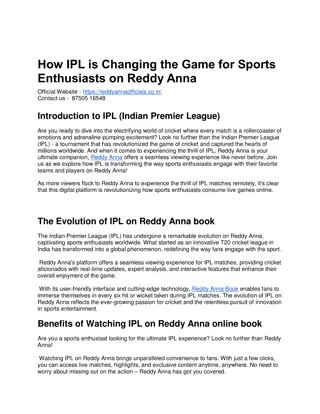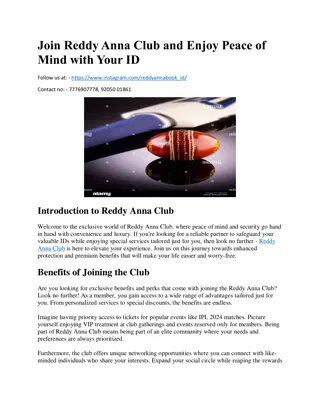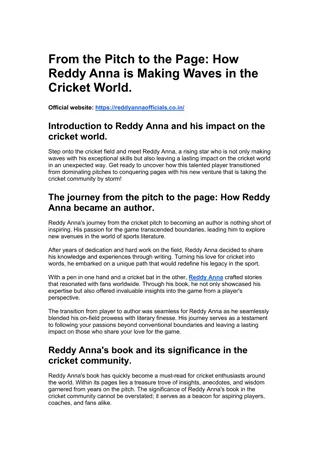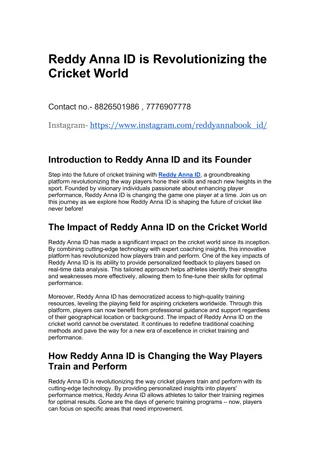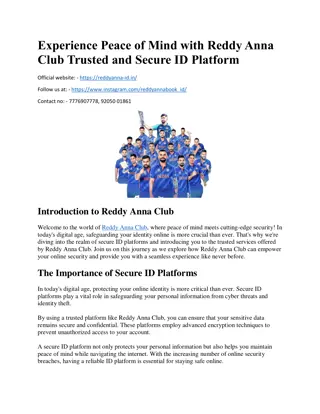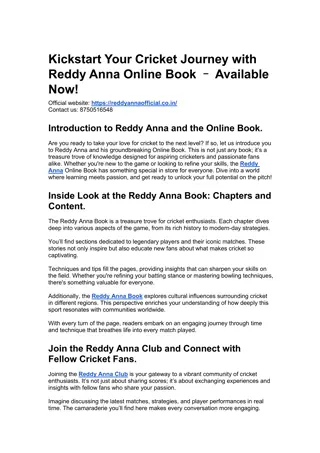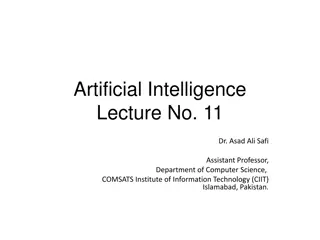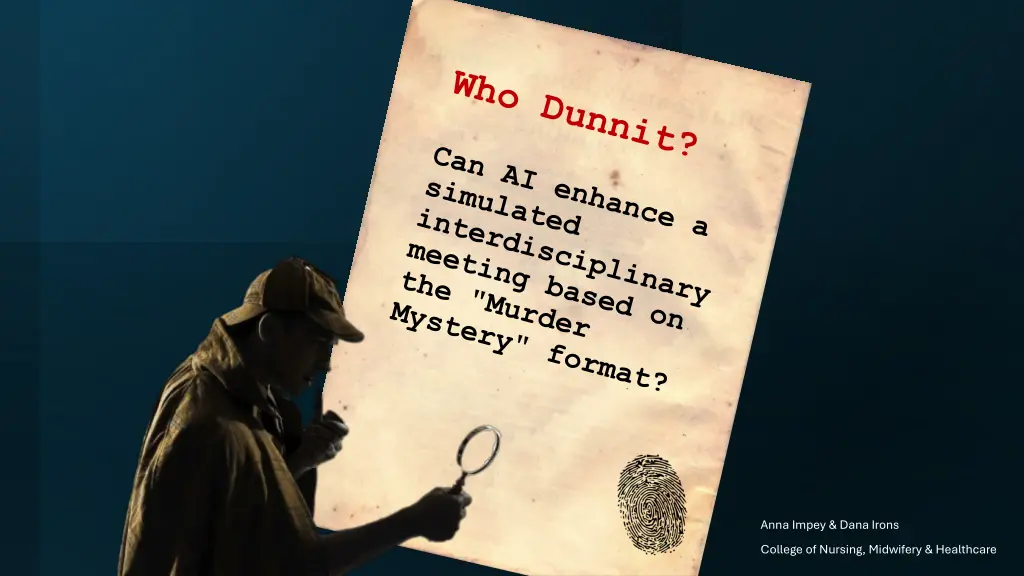
Foster Interdisciplinary Collaboration in Nursing Education
Explore a Murder Mystery learning activity in Nursing education, focusing on enhancing critical thinking and fostering interdisciplinary collaboration among students. Discover the use of Artificial Intelligence in educational simulations and its impact on diversity and equity. Join the conversation on realistic MDT meetings, authentic assessment, and addressing biases in healthcare education.
Download Presentation

Please find below an Image/Link to download the presentation.
The content on the website is provided AS IS for your information and personal use only. It may not be sold, licensed, or shared on other websites without obtaining consent from the author. If you encounter any issues during the download, it is possible that the publisher has removed the file from their server.
You are allowed to download the files provided on this website for personal or commercial use, subject to the condition that they are used lawfully. All files are the property of their respective owners.
The content on the website is provided AS IS for your information and personal use only. It may not be sold, licensed, or shared on other websites without obtaining consent from the author.
E N D
Presentation Transcript
Anna Impey & DanaIrons College of Nursing, Midwifery & Healthcare
Primary Aims of the Learning Activity: To simulate a realistic MDT meeting where nursing students can practice interdisciplinary collaboration, empowering and preparing students to participate in similar conversations in the workplace. To enhance critical thinking, communication, clinical- reasoning and decision-making skills. To understand the roles and perspectives of different healthcare and social care professionals. Secondary Aims: To evaluate the effectivenessthe"Murder Mystery" format for a simulated classroom learning activity To consider the potential role of AI inthe development of theactivity To discuss the benefits and limitations of AI in terms diversityand equity in nursing simulations
The pilot - why a murder mystery format? Constructivism - principles of problem based learning Authentic assessment High fidelity simulation Identifying conflicting information Addressing biases, pre-conceptions and hierarchy Critical analysis of information shared Disadvantages of activity - time and resource heavy, not co-produced with lived experience
"Mystery MDT": Application with a large group cohort (300+) across multiple tutor groups To what extent did the activity make you feel more confident to participate in an MDT as a nurse? How well did the activity help you to better understand the overall module learning objectives?
Employing Artificial Intelligence (AI) Pilot preceded Chat GPT - How could we use this tool? 1. Can AI reduce the time required to prepare materials? 2. Could the use of AI provide a psychologically safe alternative to lived experience? 3. Would the use of AI perpetuate or mitigate against unconscious bias and stereotyping?
Who Dunnit? Me or AI? Social Worker: Megan is well known to you. You first met her 3 years ago when you were assigned to investigate concerns from the nursery worker about neglect of her daughter. Megan has a 4-year-old child who is currently in care. "Good afternoon, I m Sarah Miller, Megan Williams s social worker. Megan has been struggling with her mental health and self-harm, which led to her daughter being placed in social care. Megan has been trying hard to stabilize her condition so she can be reunited with her daughter. Recently, she missed several of our scheduled meetings, and I was getting increasingly worried about her. My last contact with her was a brief phone call two weeks ago, where she sounded very low and disconnected. Her current situation is deeply concerning, and we need to assess her risk to herself." Megan is from an affluent family, and they continue to pay for her flat and give her money every month in her account, but have minimal direct contact. Megan attempted to disclose abuse from her mum s partner as a teen, but the family denied it and Mum stayed with her partner. Megan left home at age 17 and generally makes contact only when she needs more money. She stayed with her mum for a brief period of time in her early twenties but didn t like that her mum told her she had to take her meds to stay there. You have attempted to contact mum today but no answer. She does not have any legal power of attorney. You generally meet with Megan monthly and helped her to get a job at a local shop through a partnership organisation. When she takes her medications, she is a reliable worker, but a few months ago her manager called you to let you know that she d started acting weird and making customers feel uncomfortable. They haven t seen her in six weeks.
Bias in Simulation Limitations & Opportunities of AI
Murder mystery is an effective simulation model to enhance clinical reasoning. AI can address the primary limitation by decreasing the time burden of preparation AI can generate a diverse array of patient vignettes. However, generated prose necessitates human moderation to mitigate potential biases. AI's responses are influenced by user input, which may inherently carry unconscious biases. Any questions?
References / further reading Abr moff, M. D., Tarver, M. E., Loyo-Berrios, N., Trujillo, S., Char, D., Obermeyer, Z., .& Maisel, W. H. (2023). Considerations for addressing bias in artificial intelligence for health equity. NPJ digital medicine,6(1), 170. Bakkum, M. J., Hartjes, M. G., Pi t, J. D., Donker, E. M., Likic, R., Sanz, E., & Tichelaar, J. (2024). Using artificial intelligence to create diverse and inclusive medical case vignettes for education. British journal of clinical pharmacology,90(3), 640-648. Ferrara, E. (2023). Fairness and bias in artificial intelligence: A brief survey of sources, impacts, and mitigation strategies.Sci,6(1), 3. Flores, L., Kim, S., & Young, S. D. (2024). Addressing bias in artificial intelligence for public health surveillance. Journal of Medical Ethics,50(3), 190-194. Folz, H. N., Black, J., & Thigpen, J. (2023). Evaluation of a murder mystery activity to teach patient communication interviewing skills. Currents in Pharmacy Teaching and Learning, 15(6), 581-586. Luijten, J. C. H. B. M., Westerman, M. J., Nieuwenhuijzen, G. A. P., Walraven, J. E. W., Sosef, M. N., Beerepoot, L. V., & Verhoeven, R. H. A. (2022). Team dynamics and clinician s experience influence decision-making during Upper-GI multidisciplinary team meetings: A multiple case study.Frontiers in oncology,12, 1003506. Mackay, E. C., Patel, K. R., Davidson, C., Little, J., Tipples, K., Januszewski, A., & Ricketts, W. (2024). Simulation as an effective means of preparing trainees for active participation in MDT meetings. Future Healthcare Journal, 11(1), 100017. Makhene, A. (2019). The use of the Socratic inquiry to facilitate critical thinking in nursing education. Health SA Gesondheid, 24. Parikh, R. B., Teeple, S., & Navathe, A. S. (2019). Addressing bias in artificial intelligence in health care. Jama, 322(24), 2377-2378. Rogers, L., De Br n, A., & McAuliffe, E. (2023). Exploring healthcare staff narratives to gain an in-depth understanding of changing multidisciplinary team power dynamics during the COVID-19 pandemic. BMC health services research,23(1), 419.



